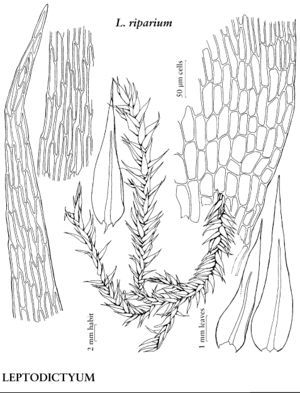Leptodictyum riparium
Krypt.-Fl. Brandenburg 2: 878. 1906.
Plants in flat, loose, long trailing mats, light green to yellowbrown. Stems 6–20 cm, flaccid, irregularly branched. Leaves erect to widespreading or appearing distichous, somewhat complanate especially in branches, often obliquely attached to stem, slightly contorted when dry, 2.5–6 mm; margins entire; apex broadly short to gradually long-acuminate; costa (45–) 52–114 µm wide at base; alar region differentiated; basal laminal cell-walls lax; distal cells (34–) 42–117 × 7–12 (–13) µm. Seta single, light to dark-brown, 0.8–2.6 cm. Capsule brown to reddish, 2.2–2.5 mm; annulus deciduous, 2-seriate or 3-seriate, cells large; operculum conic, apiculate; peristome yellow to brown. Calyptra naked.
Habitat: Humus, logs, tree bases, swamps, wet depressions in forests, aquatic on rock in streams and rivers
Elevation: low to moderate elevations
Distribution

Greenland, Alta., B.C., Man., N.B., Nfld. and Labr., N.W.T., N.S., Nunavut, Ont., P.E.I., Que., Sask., Yukon, Ala., Alaska, Ariz., Ark., Calif., Colo., Conn., Del., Fla., Ga., Ill., Ind., Iowa, Kans., La., Maine, Md., Mass., Mich., Minn., Miss., Mo., Nebr., N.H., N.J., N.Mex., N.Y., N.C., N.Dak., Ohio, Okla., Oreg., Pa., R.I., S.C., S.Dak., Tenn., Tex., Utah, Vt., Va., Wash., W.Va., Wis., Wyo., Mexico, Central America, South America, Europe, Asia, Africa, Indian Ocean Islands, Pacific Islands, Australia
Discussion
As the specific epithet implies, Leptodictyum riparium occurs along rivers, often in flooded areas where the plants are stranded on tree bases in hardwood forests. The species is sometimes confused with another wetland species, Drepanocladus aduncus, which differs by its axillary hairs with 1–3 hyaline distal cells. There is tremendous morphological variability among the North American specimens of L. riparium, suggesting the existence of several ecotypes, which have been erroneously named as many varieties and forms in Leptodictyum, Amblystegium, and Campylium; these synonyms are summarized by A. J. Grout (1928–1940, vol. 3), H. S. Conard (1959), and H. A. Crum and L. E. Anderson (1981).
Selected References
None.
Lower Taxa
"narrower" is not a number.
